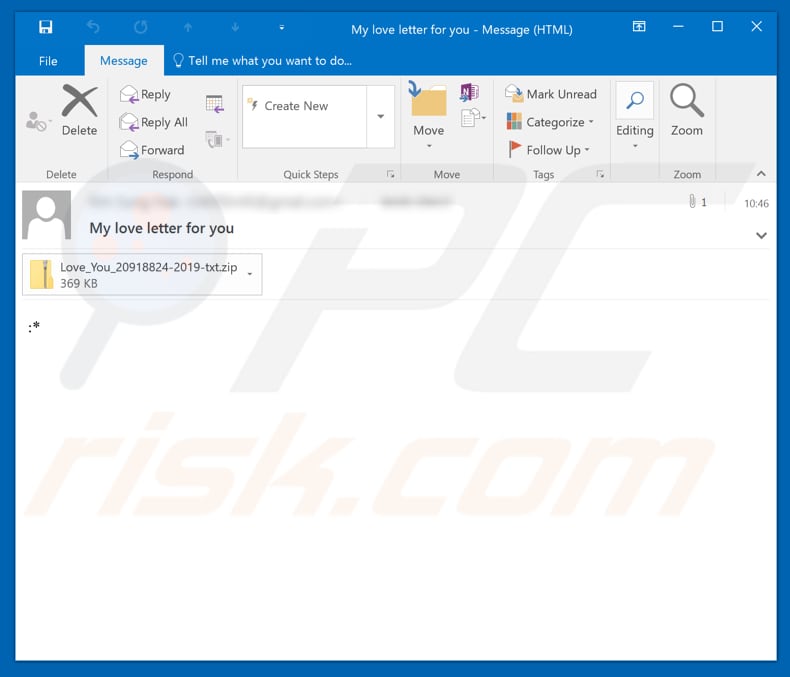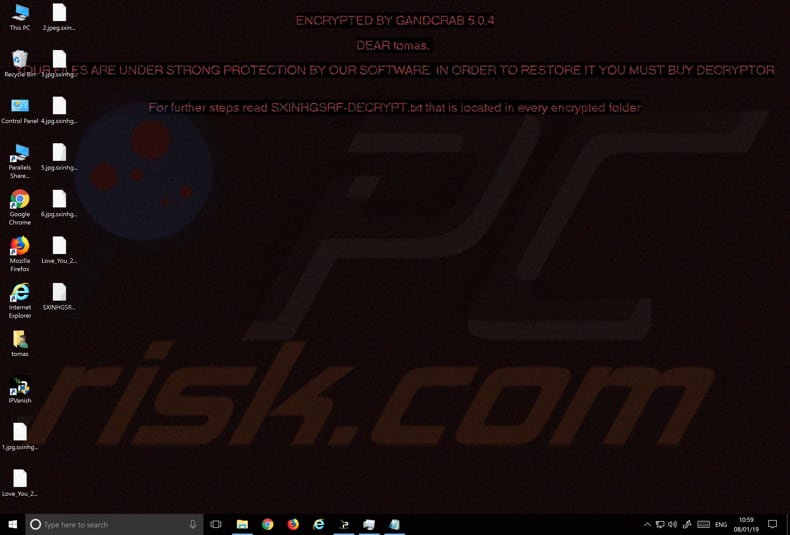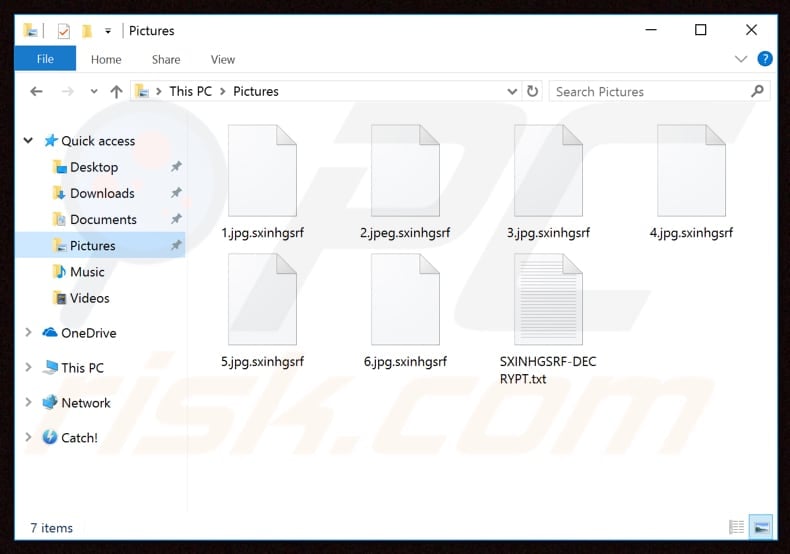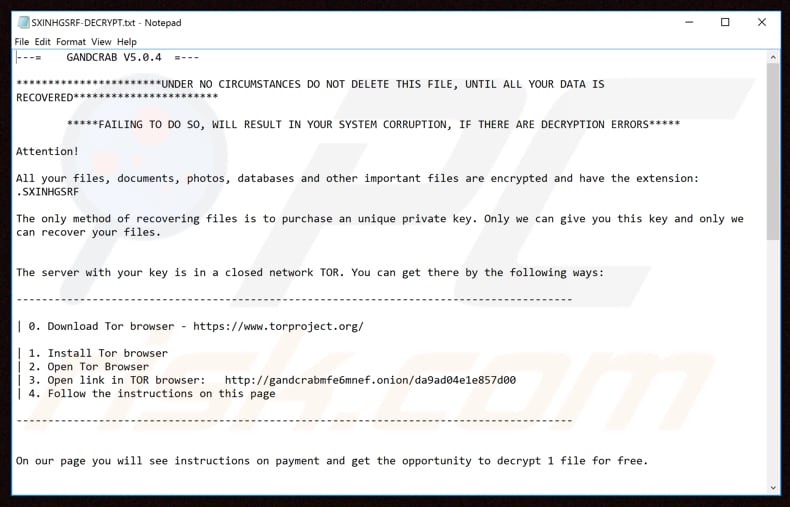Get free scan and check if your device is infected.
Remove it nowTo use full-featured product, you have to purchase a license for Combo Cleaner. Seven days free trial available. Combo Cleaner is owned and operated by RCS LT, the parent company of PCRisk.com.
What is "Love Letter Email Virus"?
"Love Letter Email Virus" is a spam campaign used by scammers (cyber criminals) to trick recipients of bogus emails into opening attachments and installing the malicious programs they contain.
The presented attachment contains a JavaScript file that downloads and installs a high-risk ransomware-type virus called GandCrab 5.0.4 and the XMRig Miner cryptocurrency miner. We strongly recommend that you avoid opening the included attachment and ignore the "Love Letter Email Virus" email.

The attachment is a ZIP archive file called "Love_You_20918824-2019-txt.zip", which contains the JavaSript file, "Love_You_20918824-2019-txt.js". Running this file results in downloading and installing the aforementioned GandCrab 5.0.4 virus and XMRig Miner cryptocurrency miner.
GandCrab 5.0.4 is ransomware-type computer infection that encrypts data and makes ransom demands. Therefore, it prevents victims from accessing their files and urges them to pay a ransom (effectively, to purchase a decryption tool or key required for data decryption).
More information about this particular ransomware-type infection can be found by clicking the link provided in the introduction above. XMRig is a cryptocurrency miner that mines Monero using the system resources of an infected computer.
Furthermore, executing the "Love_You_20918824-2019-txt.js" JavaScript file leads to various random and suspicious processes (such as "wincfg32scv.exe", "1119713827.exe", "2987227227.exe", etc.) running in Task Manager.
In summary, extracting the archive file presented in "Love Letter Email Virus" and running the included JavaScript file, causes blocked access to files (data encryption) and installation of a cryptocurrency miner. This can lead to serious problems and, therefore, you should ignore this email and not open the attachment.
| Name | Love Letter spam |
| Threat Type | Trojan, Password stealing virus, Banking malware, Spyware |
| Symptoms | Trojans are designed to stealthily infiltrate victim's computer and remain silent thus no particular symptoms are clearly visible on an infected machine. |
| Distribution methods | Infected email attachments, malicious online advertisements, social engineering, software cracks. |
| Damage | Stolen banking information, passwords, identity theft, victim's computer added to a botnet. |
| Malware Removal (Windows) |
To eliminate possible malware infections, scan your computer with legitimate antivirus software. Our security researchers recommend using Combo Cleaner. Download Combo CleanerTo use full-featured product, you have to purchase a license for Combo Cleaner. 7 days free trial available. Combo Cleaner is owned and operated by RCS LT, the parent company of PCRisk.com. |
The internet is full of scammers (cyber criminals) who proliferate various computer infections using spam email campaigns. Some examples of other similar campaigns are Outriger Email Virus, Christmas Greetings Email Virus, and Y.E DESIGN Email Virus.
Typically, cyber criminals send these emails to infect computers with viruses such as Adwind, FormBook, TrickBot, Emotet, and many others.
The aim is to generate revenue by making ransom demands, stealing personal details (such as logins, passwords), spreading additional infections, and so on. If you suspect that your computer is infected with a virus of this type, remove it immediately.
How did "Love Letter Email Virus" infect my computer?
As with most spam email campaigns, "Love Letter Email Virus" infects computers through malicious attachments (in this case, the "Love_You_20918824-2019-txt.js" JavaScript file that is placed within the "Love_You_20918824-2019-txt.zip" ZIP archive file).
In other cases, emails might contain web links leading to infected files or malicious attachments such as executable files (.exe), Microsoft Office documents, PDF documents, and so on. For example, an opened malicious MS Office document will demand permission to enable macro commands. By enabling them, users give permission to download and install computer infections.
How to avoid installation of malware?
Ignore emails (and web links or attachments presented within them) received from suspicious, unknown or untrustworthy email addresses. Bear in mind that most are presented as legitimate messages, using well-known company names. Additionally, download files (software) using official and trustworthy sources.
Having a reputable anti-spyware or anti-virus software installed can also prevent computer infection by viruses or other threats. If you have already opened the "Love Letter Email Virus" attachment, we recommend running a scan with Combo Cleaner Antivirus for Windows to automatically eliminate infiltrated malware.
Text presented in the "Love Letter Email Virus" email message:
Subject: My love letter for you
:*
Screenshot of a desktop of a computer infected by GandCrab 5.0.4 ransomware:

Screenshot of files encrypted by GandCrab 5.0.4 (victim's ID used as an extension):

Screenshot of a GandCrab 5.0.4 ransomware ransom message (the filename always differs, depending on the victim's ID - "ID-DECRYPT.txt"):

Message presented in GandCrab 5.0.4 text file:
---= GANDCRAB V5.0.4 =---
***********************UNDER NO CIRCUMSTANCES DO NOT DELETE THIS FILE, UNTIL ALL YOUR DATA IS RECOVERED***********************
*****FAILING TO DO SO, WILL RESULT IN YOUR SYSTEM CORRUPTION, IF THERE ARE DECRYPTION ERRORS*****
Attention!
All your files, documents, photos, databases and other important files are encrypted and have the extension: [victim's_ID]
The only method of recovering files is to purchase an unique private key. Only we can give you this key and only we can recover your files.
The server with your key is in a closed network TOR. You can get there by the following ways:----------------------------------------------------------------------------------------
| 0. Download Tor browser - hxxps://www.torproject.org/
| 1. Install Tor browser
| 2. Open Tor Browser
| 3. Open link in TOR browser: hxxp://gandcrabmfe6mnef.onion/da9ad04e1e857d00
| 4. Follow the instructions on this page----------------------------------------------------------------------------------------
On our page you will see instructions on payment and get the opportunity to decrypt 1 file for free.
ATTENTION!IN ORDER TO PREVENT DATA DAMAGE:
* DO NOT MODIFY ENCRYPTED FILES
* DO NOT CHANGE DATA BELOW---BEGIN GANDCRAB KEY---
-
---END GANDCRAB KEY------BEGIN PC DATA---
-
---END PC DATA---
Instant automatic malware removal:
Manual threat removal might be a lengthy and complicated process that requires advanced IT skills. Combo Cleaner is a professional automatic malware removal tool that is recommended to get rid of malware. Download it by clicking the button below:
DOWNLOAD Combo CleanerBy downloading any software listed on this website you agree to our Privacy Policy and Terms of Use. To use full-featured product, you have to purchase a license for Combo Cleaner. 7 days free trial available. Combo Cleaner is owned and operated by RCS LT, the parent company of PCRisk.com.
Quick menu:
- What is Love Letter spam?
- Types of malicious emails.
- How to spot a malicious email?
- What to do if you fell for an email scam?
Types of malicious emails:
![]() Phishing Emails
Phishing Emails
Most commonly, cybercriminals use deceptive emails to trick Internet users into giving away their sensitive private information, for example, login information for various online services, email accounts, or online banking information.
Such attacks are called phishing. In a phishing attack, cybercriminals usually send an email message with some popular service logo (for example, Microsoft, DHL, Amazon, Netflix), create urgency (wrong shipping address, expired password, etc.), and place a link which they hope their potential victims will click on.
After clicking the link presented in such email message, victims are redirected to a fake website that looks identical or extremely similar to the original one. Victims are then asked to enter their password, credit card details, or some other information that gets stolen by cybercriminals.
![]() Emails with Malicious Attachments
Emails with Malicious Attachments
Another popular attack vector is email spam with malicious attachments that infect users' computers with malware. Malicious attachments usually carry trojans that are capable of stealing passwords, banking information, and other sensitive information.
In such attacks, cybercriminals' main goal is to trick their potential victims into opening an infected email attachment. To achieve this goal, email messages usually talk about recently received invoices, faxes, or voice messages.
If a potential victim falls for the lure and opens the attachment, their computers get infected, and cybercriminals can collect a lot of sensitive information.
While it's a more complicated method to steal personal information (spam filters and antivirus programs usually detect such attempts), if successful, cybercriminals can get a much wider array of data and can collect information for a long period of time.
![]() Sextortion Emails
Sextortion Emails
This is a type of phishing. In this case, users receive an email claiming that a cybercriminal could access the webcam of the potential victim and has a video recording of one's masturbation.
To get rid of the video, victims are asked to pay a ransom (usually using Bitcoin or another cryptocurrency). Nevertheless, all of these claims are false - users who receive such emails should ignore and delete them.
How to spot a malicious email?
While cyber criminals try to make their lure emails look trustworthy, here are some things that you should look for when trying to spot a phishing email:
- Check the sender's ("from") email address: Hover your mouse over the "from" address and check if it's legitimate. For example, if you received an email from Microsoft, be sure to check if the email address is @microsoft.com and not something suspicious like @m1crosoft.com, @microsfot.com, @account-security-noreply.com, etc.
- Check for generic greetings: If the greeting in the email is "Dear user", "Dear @youremail.com", "Dear valued customer", this should raise suspiciousness. Most commonly, companies call you by your name. Lack of this information could signal a phishing attempt.
- Check the links in the email: Hover your mouse over the link presented in the email, if the link that appears seems suspicious, don't click it. For example, if you received an email from Microsoft and the link in the email shows that it will go to firebasestorage.googleapis.com/v0... you shouldn't trust it. It's best not to click any links in the emails but to visit the company website that sent you the email in the first place.
- Don't blindly trust email attachments: Most commonly, legitimate companies will ask you to log in to their website and to view any documents there; if you received an email with an attachment, it's a good idea to scan it with an antivirus application. Infected email attachments are a common attack vector used by cybercriminals.
To minimise the risk of opening phishing and malicious emails we recommend using Combo Cleaner Antivirus for Windows.
Example of a spam email:

What to do if you fell for an email scam?
- If you clicked on a link in a phishing email and entered your password - be sure to change your password as soon as possible. Usually, cybercriminals collect stolen credentials and then sell them to other groups that use them for malicious purposes. If you change your password in a timely manner, there's a chance that criminals won't have enough time to do any damage.
- If you entered your credit card information - contact your bank as soon as possible and explain the situation. There's a good chance that you will need to cancel your compromised credit card and get a new one.
- If you see any signs of identity theft - you should immediately contact the Federal Trade Commission. This institution will collect information about your situation and create a personal recovery plan.
- If you opened a malicious attachment - your computer is probably infected, you should scan it with a reputable antivirus application. For this purpose, we recommend using Combo Cleaner Antivirus for Windows.
- Help other Internet users - report phishing emails to Anti-Phishing Working Group, FBI’s Internet Crime Complaint Center, National Fraud Information Center and U.S. Department of Justice.
Share:

Tomas Meskauskas
Expert security researcher, professional malware analyst
I am passionate about computer security and technology. I have an experience of over 10 years working in various companies related to computer technical issue solving and Internet security. I have been working as an author and editor for pcrisk.com since 2010. Follow me on Twitter and LinkedIn to stay informed about the latest online security threats.
PCrisk security portal is brought by a company RCS LT.
Joined forces of security researchers help educate computer users about the latest online security threats. More information about the company RCS LT.
Our malware removal guides are free. However, if you want to support us you can send us a donation.
DonatePCrisk security portal is brought by a company RCS LT.
Joined forces of security researchers help educate computer users about the latest online security threats. More information about the company RCS LT.
Our malware removal guides are free. However, if you want to support us you can send us a donation.
Donate
▼ Show Discussion